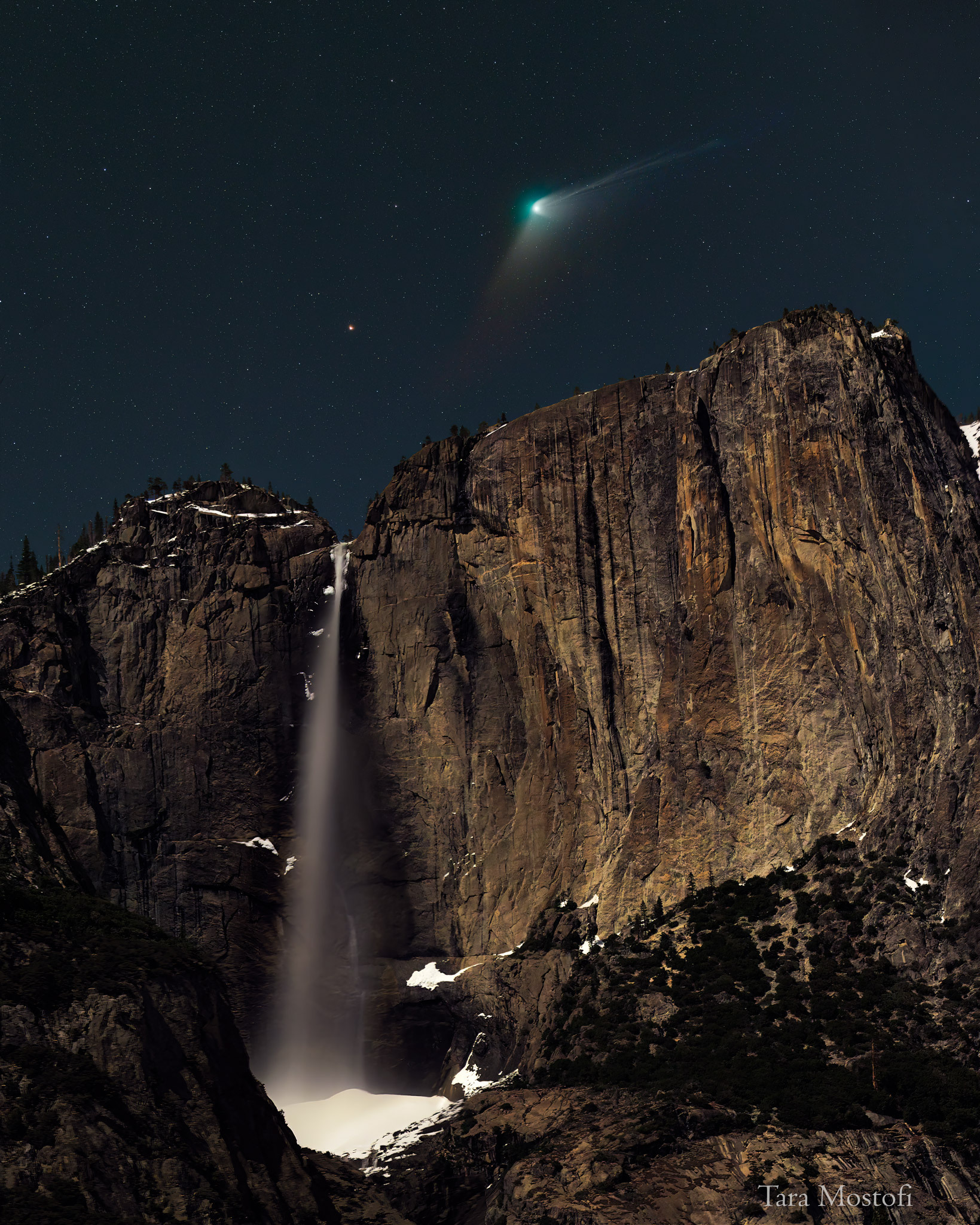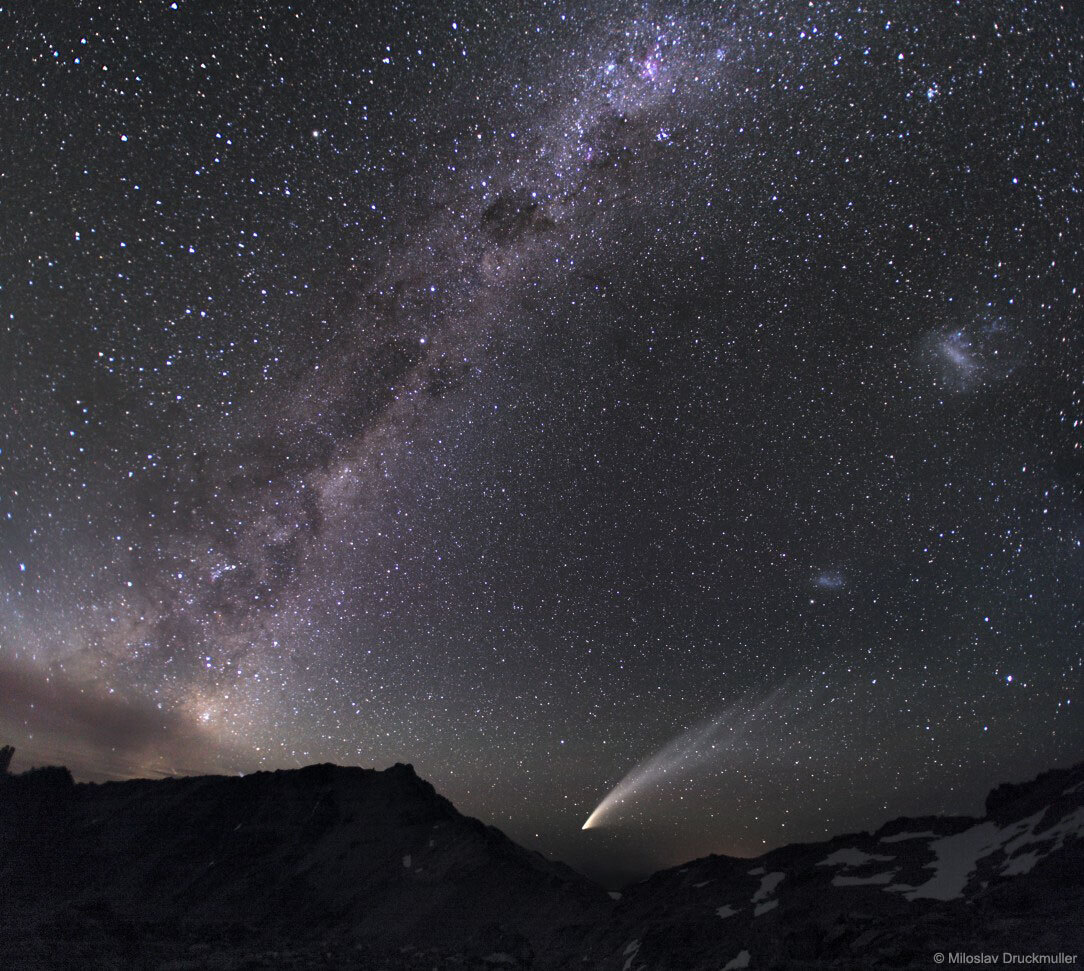#comet

#COMET #NISHIMURA AND THE ESKIMO NEBULA: Hyperbolic Comet Nishimura continues to fall into the #solar-system. On Aug. 19th it passed by the Eskimo Nebula. Bill Williams captured the conjunction just above the roof of his house in Florida's Chiefland Astro Village:
"I read about newly-discovered Comet Nishimura (C/2023 P1) on Spaceweather.com, so I decided to take the challenge of capturing it--although my observatory roof slides east and usually blocks low altitude pre-dawn objects," says Williams. "However, I was thrilled yesterday morning when not only did Comet Nishimura show up but also the Eskimo Nebula just 18 arc minutes away!!"
"Astronomical twilight was already underway when I started observing, so to accelerate the capture I took 2-minute LRGB images (binned 3x3)," he continues. "I do not know what percentage of my telescope actually captured photons from the comet, but we got a nice view of the roof gable, too. A thin ion tail also showed up! You don't know unless you try!"
Comet Nishimura is visiting the inner solar system for the first and last time. When it passes by the sun inside the orbit of Mercury on Sept. 18th, the sun's gravity will slingshot it back into deep space. It is expected to become a naked eye object (3rd magnitude) in mid-September.

Introducing #Comet #Nishimura
#Astronomy #Picture of the Day

NEW #COMET #NISHIMURA: Astronomers are monitoring a new comet that could become a naked eye-object next month. It is Comet C/2023 P1 (Nishimura), discovered just a few days ago by Japanese #amateur #astronomer Hideo Nishimura. On Aug. 15th just before dawn in June Lake, California, Dan Bartlett photographed it rising in the #constellation #Gemini:
Right now the comet is shining like a 10th magnitude star, a relatively easy target for backyard telescopes. It could become more than 100 times brighter. Forecasters believe the Comet Nishimura will brighten to 3rd magnitude in mid-September when it passes by the #sun inside the orbit of Mercury. This would make it visible to the naked eye from rural areas.
This might be a " #hyperbolic comet." In other words, it appears to have a hyperbolic orbit (e>1) with too much energy to remain inside the solar system. If so, the comet will only visit us once, with the sun acting as a gravitational slingshot, sending the comet hurtling out of the solar system after its flyby. Confirmation awaits additional, more precise measurements of its orbit.

#Comet C/2023 E1 ATLAS near #Perihelion
#Astronomy #Picture of the Day
Approaching Comet Predicted to Shine Brighter Than Stars in The Sky
"The comet's nearest approach to the Sun, or perihelion, won't be until September 28, 2024, before hitting its closest point to Earth a few weeks later on October 13, so you've got plenty of time to get your blanket and telescopes organized."
https://www.sciencealert.com/approaching-comet-predicted-to-shine-brighter-than-stars-in-the-sky

#Comet #ZTF over #YosemiteFalls
#Astronomy #Picture of the Day

GREEN #COMET, RED PLANET: Comet ZTF (C/2022 E3) is having a close encounter with #Mars. Alan Dyer of Gleichen, Alberta, photographed them together in the constellation Taurus on Feb. 10th:
"The passage of Comet C/0222 E3 (ZTF) less than 1 degree from Mars made for a photogenic grouping," says Dyer. "I shot it with several focal lengths framing the entire constellation of Taurus, then zooming in to frame the main star clusters in Taurus, then zooming in even more to frame just the comet and Mars, with Mars at the end of a long filament of dark interstellar dust."
The two celestial bodies are a study in contrast. Mars is red (due to rust in the planet's regolith). Comet ZTF is green (due to diatomic carbon in its atmosphere). Mars is 100 times brighter and easy to see with the unaided eye. Comet ZTF is nearly invisible.
Astrophotographers, point your optics at Mars and take a long exposure. The comet will appear nearby.
https://spaceweather.com/
#X-ray #Solar #Flares
6-hr max: X1 1548 UT Feb11

A DANGEROUS SUNSPOT: Sunspot AR3217 has a 'beta-gamma-delta' magnetic field that harbors energy for X-class solar flares. Indeed, it just unleashed one (see below). The sunspot is turning toward Earth so any flares this weekend are likely to be geoeffective.
SOLAR #FLARE AND RADIO BLACKOUT: Earth-orbiting satellites have just detected an X1.1-class solar flare from sunspot AR3217 (Feb. 11th @ 1548 UTC). Extreme #UV #radiation ionized the top of Earth's atmosphere, causing a strong shortwave radio blackout over South America

#Comet ZTF is approaching the ecliptic and is now near #Mars," says Jaeger. On. Saturday night they will be less than 1 degree apart.
The two celestial bodies are a study in contrast. Mars is red (due to rust in the planet's regolith). Comet ZTF is green (due to diatomic carbon in its atmosphere). Mars is 100 times brighter and easy to see with the unaided eye. Comet ZTF is nearly invisible.
https://spaceweather.com/

Für alle, die heute bedeckten Himmel haben: der #Mars und der fliehende #Komet :-)
#C/2022_E3_(ZTF) #Komet #Comet #backyardastronomy #astronomie #600mm

Nach dem ganzen bisherigen Wolkendebakel heute mal Butter bei die Fische und trotz fast vollem Mond und leichten Schleierwolken mal das 600er draufgehalten...
Dabeisein ist alles :-)
#C/2022_E3_(ZTF) #Komet #Comet #backyardastronomy #astronomie #600mm

COMET #ZTF HAS ARRIVED: It only took 50,000 years. During the #StoneAge, faraway Comet ZTF (C/2022 E3) began falling toward the inner solar system. Today it finally reached #Earth, only 0.28 AU away. This is what the comet looks like from point-blank range:
"There is a strong curved dust tail, a long blue ion tail, and a vivid green coma," says photographer Michael Jaeger of Weißenkirchen in der Wachau, Austria. "It's a beautiful comet."
The ensemble is now glowing with an integrated magnitude near +4.8. It is barely visible to the naked eye (at best, a faint smudge), but a terrific target for small telescopes. Northern observers are favored. The comet is racing through Camelopardalis (the Giraffe), a constellation near the Big Dipper and the North Star. The best time to look is during the dark hours between midnight and dawn after the Moon has set.
#SUN ERUPTS BIG AT THE #COMET #sonews
https://www.bitchute.com/video/uObvWV1HtTMx/









